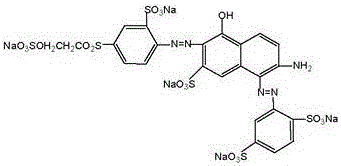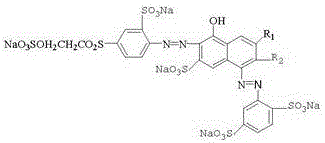Active orange dye for low temperature dyeing and preparation method thereof
A low-temperature dyeing and reactive technology, applied in the field of low-temperature dyeing reactive orange dye and its preparation, can solve the problems of poor levelness and more residual liquid, and achieve the effects of less dyeing residual liquid, high solubility and stable reaction performance.
- Summary
- Abstract
- Description
- Claims
- Application Information
AI Technical Summary
Problems solved by technology
Method used
Image
Examples
Embodiment 1
[0035] 1) Aniline 2,5-disulfonic acid diazonium: Add 54 parts of hydrochloric acid (calculated as hydrogen chloride) to 251 parts of aniline 2,5-bissulfonic acid and stir for 3 hours, then add ice to cool down at 0-3°C, then add 72 Parts of sodium nitrite (made into an aqueous solution with a mass percentage concentration of 30%), maintained at 3-7°C for 4 hours to obtain aniline 2,5-bissulfonic acid diazonium compound;
[0036] 2) Dissolution of J acid: add 236 parts of J acid into water, beat for 1 hour at 15-20°C to dissolve, and then adjust the pH value to 6.5 with sodium hydroxide solution;
[0037] 3) Primary coupling: Add aniline 2,5-bissulfonic acid diazonium compound to J acid solution, control the temperature at 0-3°C, react for 4 hours, adjust pH=3.5 with baking soda dry powder, and obtain primary coupling compound after complete reaction ;
[0038] 4) Secondary diazo: Add 361 parts of sulfonated para-ester to 43 parts of hydrochloric acid and stir for 2 hours, the...
Embodiment 2
[0044] 1) Aniline 2,5-disulfonic acid diazonium: Add 54 parts of hydrochloric acid (calculated as hydrogen chloride) to 251 parts of aniline 2,5-bissulfonic acid and stir for 3 hours, then add ice to cool down at 0-3°C, then add 72 Parts of sodium nitrite (30% solution), maintained at 3-7°C for 4 hours to obtain aniline 2,5-bissulfonic acid diazonium compound;
[0045] 2) γ-acid dissolution: add 236 parts of γ-acid into water, beat for 1 hour to dissolve at 15-20°C, and then adjust the pH value to 6.5 with sodium hydroxide solution;
[0046] 3) Primary coupling: add aniline 2,5-bissulfonic acid diazonium compound into the γ-acid solution, control the temperature at 0-3°C, react for 4 hours, adjust the pH=3.5 with baking soda dry powder, and obtain the primary coupling compound after the reaction is complete ;
[0047] 4) Secondary diazo: Add 361 parts of sulfonated para-ester to 43 parts of hydrochloric acid and stir for 2 hours, then add ice to cool down at 0-5°C, then add 6...
Embodiment 3
[0053] 1) Aniline 2,5-diazonium disulfonic acid: Add 55 parts of hydrochloric acid (calculated as hydrogen chloride) to 253 parts of aniline 2,5-bissulfonic acid and stir for 2 hours, add ice to cool down at 0-3°C, and then add 70 Parts of sodium nitrite (30% solution), maintained at 3-7°C for 3 hours to obtain aniline 2,5-bissulfonic acid diazonium compound;
[0054] 2) Gamma acid dissolution: add 239 parts of gamma acid into water, beat for 1 hour at 15-20°C to dissolve, and then adjust the pH value to 7.0 with sodium hydroxide solution;
[0055] 3) Primary coupling: add aniline 2,5-bissulfonic acid diazonium compound into the γ-acid solution, control the temperature at 0-3°C, react for 5 hours, adjust the pH=4.0 with baking soda dry powder, and obtain the primary coupling compound after the reaction is complete ;
[0056] 4) Secondary diazo: Add 365 parts of sulfonated para-ester to 43 parts of hydrochloric acid and stir for 2 hours, then add ice to cool down at 0-5°C, the...
PUM
| Property | Measurement | Unit |
|---|---|---|
| color fastness | aaaaa | aaaaa |
Abstract
Description
Claims
Application Information
 Login to View More
Login to View More - R&D
- Intellectual Property
- Life Sciences
- Materials
- Tech Scout
- Unparalleled Data Quality
- Higher Quality Content
- 60% Fewer Hallucinations
Browse by: Latest US Patents, China's latest patents, Technical Efficacy Thesaurus, Application Domain, Technology Topic, Popular Technical Reports.
© 2025 PatSnap. All rights reserved.Legal|Privacy policy|Modern Slavery Act Transparency Statement|Sitemap|About US| Contact US: help@patsnap.com



